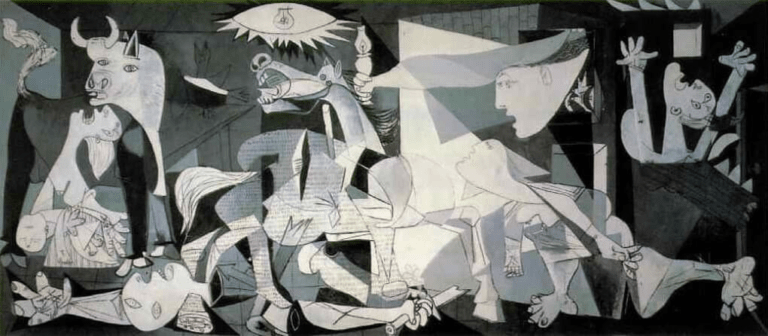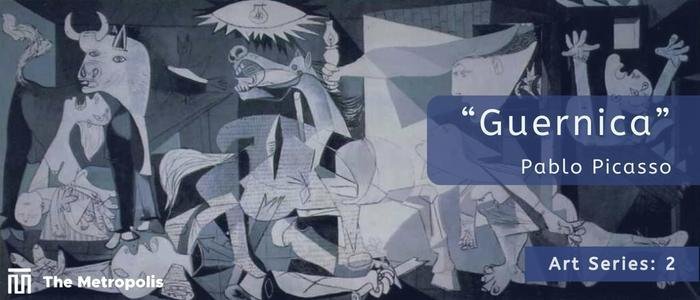Art Series: “Guernica” by Pablo Picasso
Arya Tabassum –
The painting “Guernica” by Pablo Picasso is considered one of the most powerful anti-war paintings in modern art. It was made in 1937 and depicts the bombing of Guernica, a Spanish town, by German and Italian warplanes during the Spanish Civil War. The artwork has grown to be a significant component of Spanish cultural history and contributed to the development of the Spanish national identity.

This art piece is seen as combining pastoral and epic genres. The removal of color heightens the drama and gives a reportage quality as in a photographic record. Guernica is an oil-painted mural-sized canvas that is blue, black, and white, measuring 3.5 meters (11 feet) height by 7.8 meters (25.6 feet) wide. This painting can be seen in the Museo Reina Sofia in Madrid.
Guernica became a powerful symbol of resistance against the fascist regime of General Franco and the rise of totalitarianism in Europe. It also helped to raise international awareness of the Spanish Civil War and the atrocities being committed there. Picasso’s political commitment is reflected in the painting, which was created for the Spanish Pavilion at the 1937 Paris International Exposition.
The painting’s impact extends beyond its political significance. It is considered a masterpiece of 20th-century art. The painting’s chaotic composition, with its distorted and fragmented forms, expresses the violence and suffering caused by the bombing. The event’s misery and desolation are further emphasized by the use of black and white. As a representation of the unarmed civilian casualties of war, the main character is a wailing mother holding a dead kid in her arms.
There are many conflicting and divergent interpretations of Guernica. This includes, for instance, the bull and the horse, the two key components of the mural. Professor Emerita of Modern and Contemporary Art at the University of Washington, Seattle, and art historian Patricia Failing, said, “The bull and the horse are important characters in Spanish culture. Picasso himself certainly used these characters to play many different roles over time. This has made the task of interpreting the specific meaning of the bull and the horse very tough. Their relationship is a kind of ballet that was conceived in a variety of ways throughout Picasso’s career”.
Some critics caution against placing too much faith in Guernica’s political message. For instance, Picasso’s alter ego has previously appeared as the rampaging bull, a key motif of devastation in this work, whether as a bull or Minotaur. The bull in this situation, however, most likely stands in for the fascist assault. Picasso interpreted it as implying cruelty and darkness, maybe recalling his prophetic. He added that the horse stood in for Guernica’s inhabitants.
Guernica has had a significant impact on contemporary culture. Since its inception, Guernica has grown to be seen as a symbol of the horrors of war and a plea for peace as well as an iconic representation of the 20th century.
Numerous artists have been influenced by Guernica to produce works that deal with related topics of conflict and peace. The painting’s style, which features shattered and warped figures, has been called a “Cubist anti-war statement”, and it is seen as a forerunner of the Surrealist and Abstract Expressionist movements. The strength and intensity of Guernica have moved many artists, and this has led to the emergence of numerous new art trends and styles.
Another way in which Guernica has influenced the modern world is through its role as a political statement. Picasso was a strong opponent of fascism, and the bombing of Guernica was viewed as a representation of both the barbarism of the fascist government and the horrors of war. The artwork is frequently on display in galleries and museums next to other pieces of art that deal with comparable subjects, like the Holocaust and other genocides. Guernica has contributed to spreading awareness of the perils of war and the value of peace by drawing attention to these tragedies.
Guernica has also influenced the world through its impact on political activism. Many people have been motivated to take into politics as a result of the picture, which has also served as a symbol of opposition to fascism and war. For instance, Guernica posters were frequently exhibited by demonstrators during the Vietnam War to show their opposition to combat. A potent symbol of the desire for peace, the artwork has also been utilized in anti-war protests and demonstrations all around the world.
Additionally, Guernica’s influence on popular culture has had an impact on the present world. Numerous movies, TV series, and books have all made use of the picture, making it a staple of popular culture. The painting, for instance, was included in the opening credits of the movie “Apocalypse Now”, and British music band Muse’s song “Rise Like Lions” referred to it. Guernica has contributed to spreading awareness of the horrors of war and the necessity for peace through its influence on popular culture.
Guernica continues to inspire new generations to work for peace and justice. The painting is a potent reminder of the atrocities of war and the necessity of resisting fascism and other forms of oppression. Guernica will continue to be a powerful message against war and a testament to the enduring legacy of Picasso’s art.



